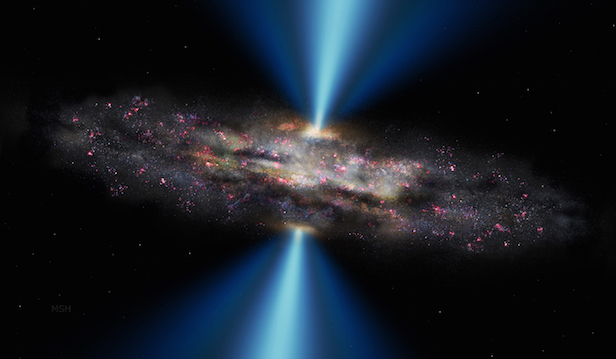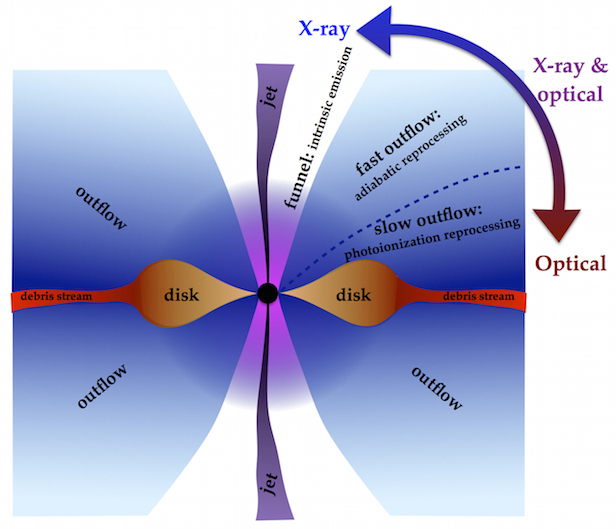New model explains how we see a black hole devour a star
Researchers have come up with a theory explaining why we see different radiation from the same star-destroying event

Tidal disruption events are caused by a star being torn apart by the intense gravity of a galaxy’s central black hole. Image credit: M. Helfenbein, Yale University/OPAC
A new theory has been proposed to explain the extremely destructive events of when a star gets ripped apart by the gravity of a supermassive black hole. This event, also known as a tidal disruption event (TDE), produces a bright flare of radiation. It’s from these observations of the flares that theoretical physicists at the University of Copenhagen’s Niels Bohr Institute and UC Santa Cruz have been able to produce this unified model.
“Only in the last decade or so have we been able to distinguish TDEs from other galactic phenomena, and the new model will provide us with the basic framework for understanding these rare events,” says Enrico Ramirez-Ruiz, professor and chair of astronomy and astrophysics at UC Santa Cruz and Niels Bohr Professor at the University of Copenhagen.
In a lot of observable galaxies, the black hole that resides at the centre is largely inactive in terms of consuming surrounding material and emitting any light. TDEs are rarely come across as they only happen once every 10,000 years in a typical galaxy. When an unfortunate star creeps close enough to be caught up in the gravity of the black hole, stellar material rains down on the black hole and causes a bright emission of intense radiation.
“It is interesting to see how materials get their way into the black hole under such extreme conditions,” says Jane Lixin Dai, assistant professor at the University of Copenhagen. “As the black hole is eating the stellar gas, a vast amount of radiation is emitted. The radiation is what we can observe, and using it we can understand the physics and calculate the black hole properties. This makes it extremely interesting to go hunting for tidal disruption events.”
It is thought that the same physics occur in each TDE, but about 24 of them have exhibited different observed properties. Some emit mostly X-rays, others emit mostly visible and others emit mostly ultraviolet light. The aspect theorists are having trouble in understanding is this diversity, and they are trying to piece together the puzzle with a coherent model.

Emissions from a TDE vary depending on the orientation of the black hole. Image credit: J. L. Dai
In this new model, the angle at which the observer views the galaxy accounts for the differences in the observations. “It is like there is a veil that covers part of a beast,” Ramirez-Ruiz explains. “From some angles we see an exposed beast, but from other angles we see a covered beast. The beast is the same, but our perceptions are different.”
Dai and her collaborators developed this model that combines elements of general relativity, magnetic fields, radiation and gas hydrodynamics. It shows what astronomers can expect to see depending on different angles, thus allowing them to fit the observations to the coherent framework.
Survey projects planned for the next few years should provide more data on TDEs, which will broaden the horizon for this field of research. Such surveys include the Young Supernova Experiment (YSE) led by the DARK Cosmology Centre at the Niels Bohr Institute and UC Santa Cruz and the Large Synoptic Survey Telescopes that are being built in Chile. “We will observe hundreds to thousands of tidal disruption events in a few years. This will give us a lot of ‘laboratories’ to test our model and use it to understand more about black holes,” says Dai.
Keep up to date with the latest reviews in All About Space – available every month for just £4.99. Alternatively you can subscribe here for a fraction of the price!




